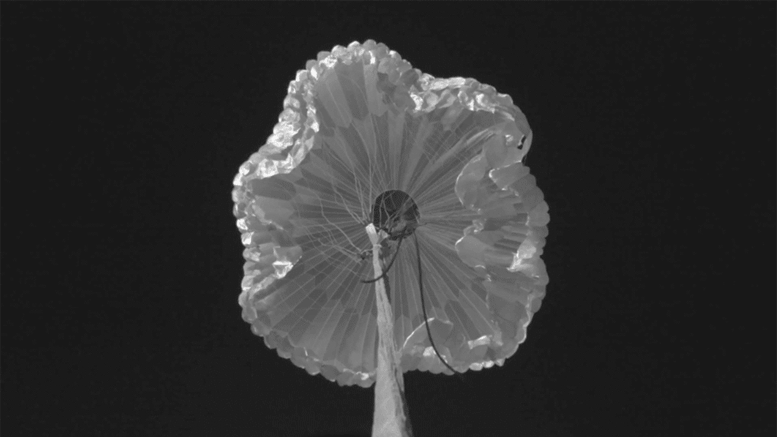
This high-definition image was taken on September 7, 2018, during the third and final test flight of the ASPIRE payload. It was the fastest inflation of this size parachute in history and created a peak load of almost 70,000 pounds of force. Credit: NASA/JPL-Caltech
In the early hours of September 7, NASA broke a world record.
Less than 2 minutes after the launch of a 58-foot-tall (17.7-meter) Black Brant IX sounding rocket, a payload separated and began its dive back through Earth’s atmosphere. When onboard sensors determined the payload had reached the appropriate height and Mach number (38 kilometers altitude, Mach 1.8), the payload deployed a parachute. Within four-tenths of a second, the 180-pound (82-kilogram) parachute billowed out from being a solid cylinder to being fully inflated.
It was the fastest inflation in history of a parachute this size and created a peak load of almost 70,000 pounds (32,000 kilograms) of force.
Watch as NASA tests a new parachute for landing the Mars 2020 rover on the Red Planet. On September 7, NASA’s ASPIRE project broke a record when its rocket-launched parachute deployed in 4-10ths of a second—the fastest inflation of this size chute in history.
This wasn’t just any parachute. The mass of nylon, Technora and Kevlar fibers that make up the parachute will play an integral part in landing NASA’s state-of-the-art Mars 2020 rover on the Red Planet in February 2021. The Jet Propulsion Laboratory’s Advanced Supersonic Parachute Inflation Research Experiment (ASPIRE) project conducted a series of sounding rocket tests to help decide which parachute design to use on the Mars 2020 mission.
Two different parachutes were evaluated during ASPIRE. The first test flight carried almost an exact copy of the parachute used to land NASA’s Mars Science Laboratory successfully on the Red Planet in 2012. The second and third tests carried chutes of similar dimensions but reinforced with stronger materials and stitching.
On October 3, NASA’s Mars 2020 mission management and members of its Entry, Descent, and Landing team met at JPL in Pasadena, California, and determined that the strengthened parachute had passed its tests and was ready for its Martian debut.
“Mars 2020 will be carrying the heaviest payload yet to the surface of Mars, and like all our prior Mars missions, we only have one parachute and it has to work,” said John McNamee, project manager of Mars 2020 at JPL. “The ASPIRE tests have shown in remarkable detail how our parachute will react when it is first deployed into a supersonic flow high above Mars. And let me tell you, it looks beautiful.”
The 67,000-pound (30,400-kilogram) load was the highest ever survived by a supersonic parachute. That’s about an 85 percent higher load than what scientists would expect the Mars 2020 parachute to encounter during its deployment in Mars’ atmosphere.
“Earth’s atmosphere near the surface is much denser than that near the Martian surface, by about 100 times,” said Ian Clark, the test’s technical lead from JPL. “But high up – around 23 miles (37 kilometers) – the atmospheric density on Earth is very similar to 6 miles (10 kilometers) above Mars, which happens to be the altitude that Mars 2020 will deploy its parachute.”
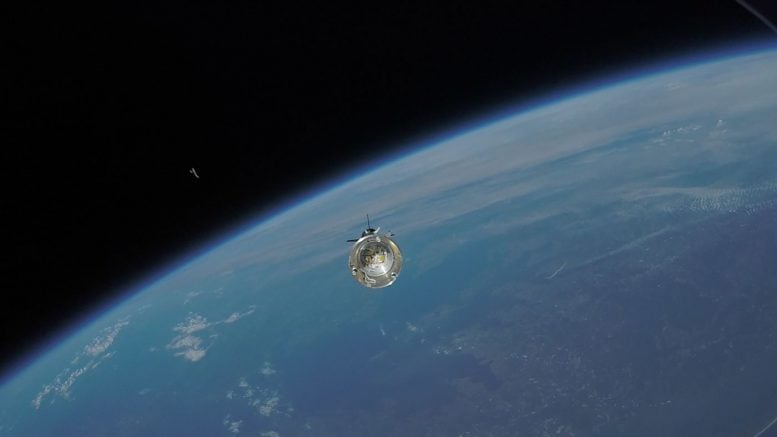
In this image, the second stage of the Black Brant IX sounding rocket separates from the ASPIRE payload. The third and final flight test of the ASPIRE payload was launched from NASA’s Wallops Flight Facility on September 7, 2018. Credit: NASA/JPL-Caltech
With the ASPIRE tests complete, the endeavors of Clark and his compatriots will be confined to the lower part of the stratosphere for the time being. But that doesn’t mean the fun times are over.
“We are all about helping 2020 stick its landing 28 months from now,” said Clark. “I may not get to shoot rockets to the edge of space for a while, but when it comes to Mars – and when it comes to getting there and getting down there safely – there are always exciting challenges to work on around here.”
The Mars 2020 project’s parachute-testing series, ASPIRE, is managed by the Jet Propulsion Laboratory, with support from NASA’s Langley Research Center in Hampton, Virginia, and NASA’s Ames Research Center in Mountain View, California, for NASA’s Space Science Mission Directorate. NASA’s Sounding Rocket Program is based at the agency’s Wallops Flight Facility on Wallops Island, Virginia. Northrop Grumman provides mission planning, engineering services and field operations through the NASA Sounding Rocket Operations Contract. NASA’s Heliophysics Division manages the sounding-rocket program for the agency.



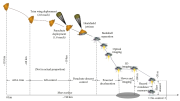


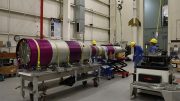
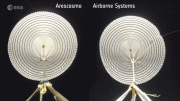

NASA is wasting huge amounts of money on obsolete technology, including this parachute thing. I have successfully converted centrifugal force into directed thrust in a completely closed unit with no external moving parts and no external vents. It is called a Centrifugal Propeller and it is capable of reaching Mars in under 10 hours. It will also give the spacecraft completely controlled entry into an atmosphere. I HAVE A WORKING PROTOTYPE!!!! In the next few weeks I will be having a press conference with a public demonstration of the prototype. About 3 months ago I went to Ottawa to meet with two Government of Canada officials. One of them has 4 degrees, two of which are in engineering and physics. After viewing the prototype he kept repeating, “you are going to win the Nobel Prize”. It has been almost impossible to get decision makers to take me seriously. After people actually see the prototype in action, they come away as believers. I hate to see NASA, Spacex, Blue Origin, etc., spending hundreds of millions of dollars on what is essentially obsolete technology, when they could be using the Centrifugal Propeller.